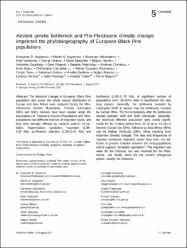| dc.contributor.author | Naydenov, Krassimir D. | |
| dc.contributor.author | Naydenov, Michel K. | |
| dc.contributor.author | Alexandrov, Alexander | |
| dc.contributor.author | Vasilevski, Kole | |
| dc.contributor.author | Hinkov, Georgi | |
| dc.contributor.author | Matevski, Vlado | |
| dc.contributor.author | Bogunic, Faruk | |
| dc.date.accessioned | 2019-10-20T08:00:43Z | |
| dc.date.available | 2019-10-20T08:00:43Z | |
| dc.date.issued | 2017 | |
| dc.identifier.issn | 1612-4669 | |
| dc.identifier.issn | 1612-4677 | |
| dc.identifier.uri | https://dx.doi.org/10.1007/s10342-017-1069-9 | |
| dc.identifier.uri | https://hdl.handle.net/11421/16160 | |
| dc.description | WOS: 000417160500001 | en_US |
| dc.description.abstract | The historical changes in European Black Pine population size across the whole natural distribution in Europe and Asia Minor were analyzed facing the Plio-Pleistocene climatic fluctuations. Thirteen chloroplast SSRs and SNPs markers have been studied under the assumptions of "neutral evolution." Populations and meta-populations had different histories of migration routes, and they were strongly affected by complex patterns of isolation, fragmentation, speciation, expansion (1.88-4.28 Ma), purification selection (2.09-21.41 Ma) and bottleneck (1.85-21.76 Ma). A significant number of populations (min. 29-41%) were in equilibrium for very long periods. Generally, the bottleneck revealed by chloroplast DNA is weaker than the bottleneck revealed by nuclear DNA. The N (e) immediately after the bottleneck reaches between 1820 and 3640 individuals. Generally, the historical effective population sizes shrink significantly for the Tertiary period from 10-15 up to 2.5 Ma in Western Europe (by 82%), followed by Asia Minor (69%) and the Balkan Peninsula (28%), likely resulting from important climatic changes. The rates and frequencies of stepwise westwards migration waves have been not sufficient to prevent isolation between the meta-populations and to suppress "sympatric speciation." The migration was weak for the Pliocene, but was maximal for the Pleistocene, and finally silent for the present interglacial period, namely the Holocene. | en_US |
| dc.language.iso | eng | en_US |
| dc.publisher | Springer | en_US |
| dc.relation.isversionof | 10.1007/s10342-017-1069-9 | en_US |
| dc.rights | info:eu-repo/semantics/openAccess | en_US |
| dc.subject | Pinus Nigra | en_US |
| dc.subject | Plio-Pleistocene Climatic Fluctuations | en_US |
| dc.subject | Cpdna | en_US |
| dc.subject | Historical Effective Population Size | en_US |
| dc.subject | Expansion | en_US |
| dc.subject | Equilibrium | en_US |
| dc.subject | Bottleneck | en_US |
| dc.subject | Migration | en_US |
| dc.title | Ancient genetic bottleneck and Plio-Pleistocene climatic changes imprinted the phylobiogeography of European Black Pine populations | en_US |
| dc.type | article | en_US |
| dc.relation.journal | European Journal of Forest Research | en_US |
| dc.contributor.department | Anadolu Üniversitesi, Fen Fakültesi, Biyoloji Bölümü | en_US |
| dc.identifier.volume | 136 | en_US |
| dc.identifier.issue | 5.Haz | en_US |
| dc.identifier.startpage | 767 | en_US |
| dc.identifier.endpage | 786 | en_US |
| dc.relation.publicationcategory | Makale - Uluslararası Hakemli Dergi - Kurum Öğretim Elemanı | en_US |


















